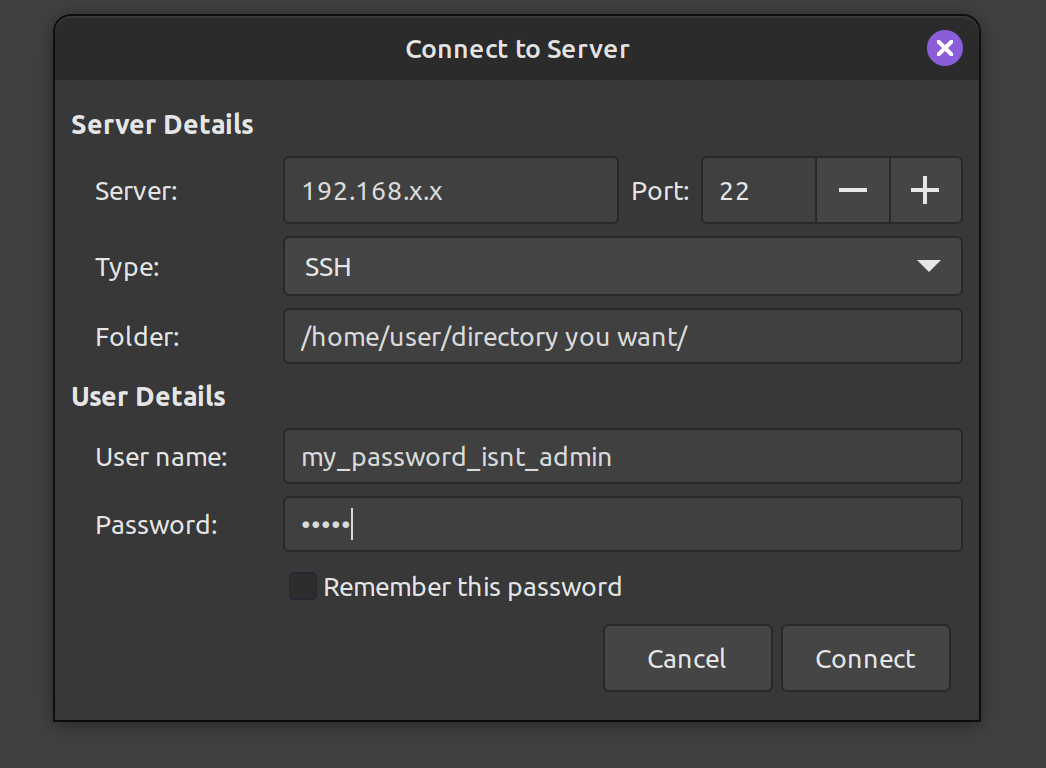rsync for backups. SMB / NFS for things I need on a daily basis. SSH FTP (use whatever client you want) for things I need rarely but don't wanna bother with SCP and I especially don't bother ever setting up vsftpd for 'real' FTP.
Selfhosted
A place to share alternatives to popular online services that can be self-hosted without giving up privacy or locking you into a service you don't control.
Rules:
-
Be civil: we're here to support and learn from one another. Insults won't be tolerated. Flame wars are frowned upon.
-
No spam posting.
-
Posts have to be centered around self-hosting. There are other communities for discussing hardware or home computing. If it's not obvious why your post topic revolves around selfhosting, please include details to make it clear.
-
Don't duplicate the full text of your blog or github here. Just post the link for folks to click.
-
Submission headline should match the article title (don’t cherry-pick information from the title to fit your agenda).
-
No trolling.
Resources:
- selfh.st Newsletter and index of selfhosted software and apps
- awesome-selfhosted software
- awesome-sysadmin resources
- Self-Hosted Podcast from Jupiter Broadcasting
Any issues on the community? Report it using the report flag.
Questions? DM the mods!
It's not very sexy, but I just use SFTP and filezilla. Filezilla is available for all the major operating systems, and an ssh server is basically required anyways.
Plex/Jellyfin is automatically managed by Sonarr/Radarr so I don't touch those.
But for game servers I use Pterodactyl which has a nice WebUI to manage the server and its files, and has automated backups.
pterodactyl looks really neat, will definitely look into that. I have a manual system for my media library, so I want to add the directories with artwork and movies manually to the directory which jellyfin reads.
https://github.com/filebrowser/filebrowser might be what you want for that, just a basic web based file management tool.
But you could also just use SMB and access the shares directly from file explorer.
Being the weirdo I am I have 2 things I use.
WinSCP to get that classic FTP look of file transfers and VS Code when working on smaller compose files.
Linux?
I just use sshfs to mount ssh shares and move files between them like any other folder.
Same with samba shares (windows).
I use rsync and SFTP to transfer files to a remote server and NFS over the LAN.
I use samba for normal usage and rsync for backups.
Do you automate your backups in some way? And can you also use samba remotely
For automatic stuff I use synching to keep my home an documents in sync.
I don't normally use samba remotely but I have a wire guard VPN that I connect to if I'm not at home and that gives me access to samba or any other "local" services I might need when away
Acronyms, initialisms, abbreviations, contractions, and other phrases which expand to something larger, that I've seen in this thread:
| Fewer Letters | More Letters |
|---|---|
| DNS | Domain Name Service/System |
| HTTP | Hypertext Transfer Protocol, the Web |
| Plex | Brand of media server package |
| SSH | Secure Shell for remote terminal access |
| SSL | Secure Sockets Layer, for transparent encryption |
| TLS | Transport Layer Security, supersedes SSL |
| VPN | Virtual Private Network |
7 acronyms in this thread; the most compressed thread commented on today has 6 acronyms.
[Thread #576 for this sub, first seen 5th Mar 2024, 18:25] [FAQ] [Full list] [Contact] [Source code]
Sftp using the KDE file browser Dolphin. Keeps it simple for my monkey brain as if I'm accessing the drive locally.
Nemo/most file explorers have a remote server option. For nemo, "Files > Connect to server". Once configured, you should be able to view your server files from your file explorer and uploading files should be as easy as drag and drop. I'm pretty sure nautilis has something similar too!

It's not the best for security because if someone gets your computer, they can access your server through the file explorer. But it's fast and convenient if you are already using your file explorer.
Generally you can even just type it into the location bar, no need to find a specific dialog. For example if I type CTRL+l then sftp://myserver.local into Nautilus it pops up a username+password dialog (or just logs in using my keys).